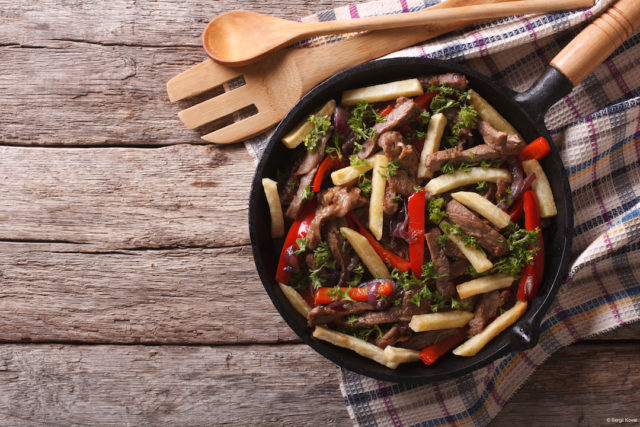Delicious Explorations: Asian Influences on Peruvian Cuisine
ABOUT
At Our Whole Village, we plan meaningful vacations for families who want to create lifelong memories and show their kids the world in a more conscious and intentional manner.
WORK WITH US
We help families take meaningful vacations so that they can escape everyday life, show their kids the world and make lifelong memories - with care, confidence and peace of mind.
THE BEST FAMILY VACATIONS BY AGE
Your (free) guide to the top travel destinations for families with babies, teens and everyone in between.
DOWNLOAD NOW
ABOUT US
June 7, 2018
Did you know that Peru boasts 600,000 descendants of Chinese and Japanese migrants? That makes it the second largest Asian population in Latin America? Chinese immigrants to Peru are known locally as “Tusán” and Japanese immigrants “Nikkei.” Prominent Asian influences are many in Peru, especially when it comes to Peruvian cuisine.
From food to politics, Japanese and Chinese Peruvians have had a major impact on the country. Learn more about the Asian influences on Peruvian dishes below.
How It All Started
Today, three to five percent of the total population of Peru have Asian roots. It’s no wonder that Asian cultural influences run deep! The first Asians to Peru came from China. Chinese Peruvians started arriving in the mid-19th century as indentured workers. They were employed on plantations formerly worked by African slaves.
Japanese immigrants to Peru came around the turn of the century. They, too, sought employment opportunities not available to them in Japan. In both cases, the Chinese and Japanese faced tough working conditions. Many died of disease, malnutrition, and poor medical care.
For those Tusán and Nikkei who survived, a world of new opportunities emerged. Many started their own businesses, particularly restaurants. As a result, they reshaped local economies and Peruvian food while establishing thriving Asian communities.
Chinese-Peruvian Cuisine
From Lima to Cuzco to Iquitos, Chinese Peruvian restaurants, or Chifas, flourish. Offering a harmonious blending of Peruvian and Chinese food, they serve delectable dishes like:
- Lomo saltado, an exquisite stir-fry of beef, tomatoes, onions, and potatoes marinated in soy sauce
- Pollo enrollado, flattened chicken breast stuffed with vegetables or pork, rolled, and fried or sautéed
- Arroz chaufa especial, fried rice featuring Chinese vegetables with your choice of hardboiled quail eggs, shrimp, or other meat
These mouthwatering Chinese-Peruvian recipes represent but a small sampling of the Chifa cuisine Peru boasts.

© Sergii Koval | Dreamstime.com
Japanese-Peruvian Cuisine
Japanese immigrants to Peru also transported essential elements of their cuisine to their new home. In so doing, they created Nikkei food. One gem of Nikkei cooking? Yaki soba saltado or “Japanese-style lo mein.” It features juicy pieces of stir-fried meat (such as chicken or shrimp), onions, and cabbage tossed with noodles and soy sauce.

© Tul Chalothonrangsee | Dreamstime.com
But the influences don’t stop there. Even Peru’s national dish, ceviche, draws on influences from Nikkei cuisine. According to chef Mina Newman, “In Peru, they used to cook seafood until it was done, done, done. They used to cook ceviche for hours… It’s because of the Japanese influences that we’ve learned to handle the fish better.” In fact, ceviche’s raw preparation hearkens back to sashimi. Sashimi is a Japanese delicacy consisting of very fresh raw meat or fish sliced into thin pieces.
Asian Influences on Peruvian Cuisine
Immigrants from China and Japan came to Peru in search of better lives and more opportunities. Many intended to return to their homelands. But after three generations, they remain a vital part of Peru’s culture, and their Asian influences have forever marked Peruvian cuisine.
Ready to taste some delectable Asian-inspired Peruvian dishes? Check out our upcoming Peru family adventure for the whole family, a great way to experience authentic Asian-Peruvian cuisine.
You’ll also enjoy checking out our free Around the World in 12 Recipes cookbook. Featuring kid-friendly recipes, your whole family will delight in preparing and enjoying these international flavors together.
We’re here to help you and your family experience the world, its people, and cultures. Contact us today to learn more about the unforgettable experiences that we handcraft to introduce your family to the world, raise good global citizens and make a difference.
OUR SERVICES
HOME
COPYRIGHT © OUR WHOLE VILLAGE 2021
DESIGN BY GIRLBOSS DESIGNER | CUSTOMIZED BY ALEX COLLIER DESIGN
about
TRAVEL SERVICES
DESTINATIONS
BLOG
PLAN A TRIP
FREE TRAVEL GUIDE
TERMS AND CONDITIONS
hello@ourwholevillage.com
+1 305 432 2612